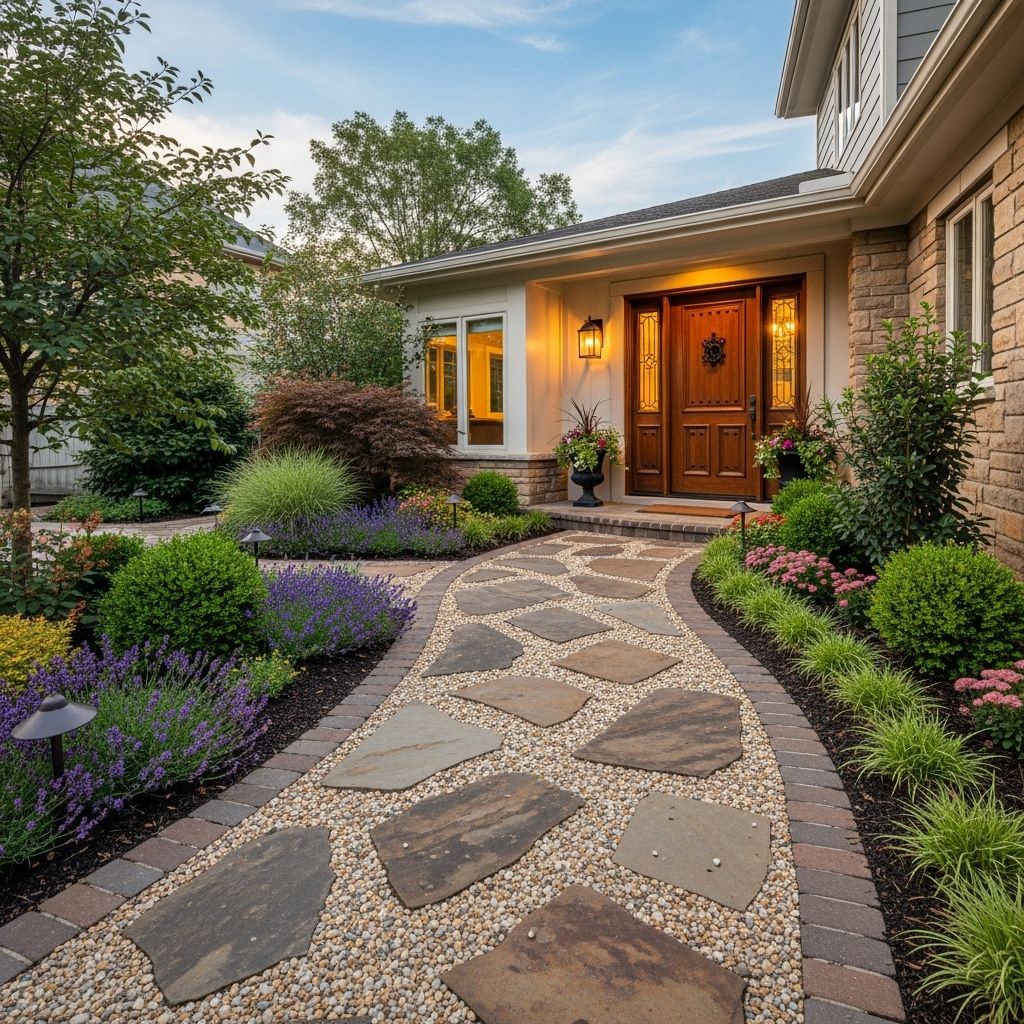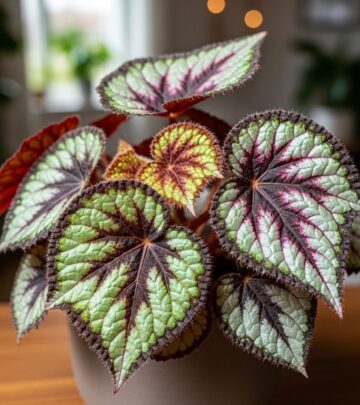Hardscaping 101: Designing Inviting Front Paths for Your Home
Strategic design choices and material pairings set the scene for a welcoming home entry.

Image: HearthJunction Design Team
Few elements of landscape design have a greater impact on the welcoming impression of your home than the front path. Whether you’re aiming to boost curb appeal or simply create a more inviting approach, understanding the essentials of front path hardscaping is key. Use this in-depth guide to plan and execute a pathway that balances function, design, and long-lasting style.
Why the Front Path Matters
Your front path is one of the first aspects that visitors (and prospective buyers) notice. It complements the architecture, helps define the landscape’s aesthetic, and sets the mood for what lies beyond the door. The right path should be both welcoming and functional, forming a seamless transition between street, garden, and home.
Core Design Principles for Front Paths
When planning your front path, follow proven design conventions that enhance usability and appearance:
- Match the path to your home’s architecture: Choose curves, lines, materials, and even plants that harmonize with your home’s style, whether modern, traditional, cottage, or contemporary.
- Path width: Maintain a minimum width of 4 feet and a maximum of 6 feet. Four feet is wide enough for two people to pass comfortably, while anything exceeding six feet can overwhelm most entryways.
- Route selection: Identify points where visitors are likely to step off the walk and adjust the route accordingly. The shortest line isn’t always best—sometimes a curved or angled path creates a more welcoming, engaging approach and prevents shortcuts across lawns or beds.
Design Considerations
- Symmetry or asymmetry: For more formal homes, a straight, symmetrical path can make a powerful statement. Informal houses, or those in natural settings, often benefit from gently winding paths.
- Edges and transitions: Combine planting beds, edging stones, or low hedges to soften the look and clearly delineate the path area.
- Viewpoints: Highlight sightlines to architectural features or garden focal points, such as doors, sculptures, or specimen trees.
Optimal Dimensions: Width, Scale, and Proportion
The most walkable and attractive front paths follow these dimensional rules:
- Width: Never less than 4 feet; never more than 6 feet. This allows two people to walk side-by-side in comfort.
- Proportion: Scale the path to your house’s entry. Large facades or double doors can handle the upper limit of width, while modest houses look best with slightly narrower paths.
- Transitions: At bends or entry points, consider slightly flaring or widening the path for a gracious feel.
Choosing the Best Materials for Your Front Path
Front path materials largely define the tone, durability, and required maintenance of your entrance. Materials span a range from economical and informal to classic and enduring.
| Material | Pros | Cons | Formality | Maintenance |
|---|---|---|---|---|
| Gravel | Low cost, easy DIY, good drainage | Messy, can migrate, less stable surface | Informal | Occasional raking/refilling |
| Decomposed Granite | Natural look, permeable | Can stick to shoes, requires stabilizer | Informal to semi-formal | Regular top-ups |
| Concrete Slabs | Durable, smooth surface, affordable | Can crack, less charm | Semi-formal | Low |
| Concrete Pavers | Uniform, many styles | Prone to settling; weeds in joints | Formal to semi-formal | Weed control needed |
| Fieldstone (Bluestone, Sandstone, Granite, Limestone) | Classic, natural elegance | Expensive, labor-intensive | Formal to rustic | Minimal |
| Brick | Charming, traditional, variety of layouts | Slippery when wet, can shift | Formal | Occasional leveling |
| Mortar-set Fieldstone | Smooth, never shifts | Highest cost and labor | Highly formal | Very low |
Material Selection Tips
- Match materials to your home’s period and architectural detailing for a cohesive look.
- Factor in local climate; some stones do better in freeze-thaw regions, for instance.
- Always install a stable foundation/base to prevent shifting and settling.
How Patterns and Layouts Impact Space
Layout choices—straight, curved, staggered, or spaced—affect not just aesthetics but also how the garden feels. Use spaced flagstones or pavers to break up visual mass and create the illusion of larger spaces. On the other hand, a continuous solid path is generally easiest for walking and most accessible for all users.
Popular Layout Approaches:
- Solid paths: Offer clear, uninterrupted access with minimal risk of tripping. Best for high-traffic areas.
- Stepping stones: With grass or gravel between, these visually expand your yard and create an organic, playful mood. Note that they require regular maintenance.
- Patterned pavers or bricks: Herringbone, basketweave, or running bond lend visual interest and can echo details from the house.
Softening and Accenting with Edging and Plantings
To break the hardness of stone or concrete and extend curb appeal, add edge treatments:
- Line paths with low-growing perennials, groundcovers, or ornamental grasses. These create a boundary and soften transitions.
- Classic brick or stone edgings provide both structure and style.
- For a dynamic look, alternate between formal hedges and more relaxed plantings.
Bear in mind that perennial borders often need replanting every 8–10 years, especially if they’re subject to heavy traffic or varying light conditions.
Lighting for Safety and Ambiance
Well-chosen pathway lighting enhances both welcoming effect and safety. Consider these guidelines:
- Space fixtures 10–15 feet apart to create gentle pools of light rather than a harsh runway effect.
- Alternate lighting from side to side to avoid overly symmetrical, artificial patterns.
- Position lights just off the pathway edge to highlight both the walk and any adjacent plantings.
- Select heights in scale with plant borders—make lights slightly taller than surrounding vegetation.
- Opt for low wattage for subtlety; always direct light downward to illuminate the path, not blind the eye.
Examples include stake lights for classic looks, flush-inset LEDs for contemporary design, or lanterns for a cottage-style effect.
Front Path Recap: What to Remember
- Design your path to complement your home’s style and landscape.
- Maintain a width between 4 and 6 feet for comfort and proportion.
- Choose materials for durability, climate compatibility, and maintenance requirements.
- Solid paths offer best accessibility; spaced pavers create visual space.
- Consider edging and softening details: perennial borders, hedges, or hardscape edging.
- Use thoughtfully placed lighting for safety and after-dark curb appeal.
Comparing Common Front Path Materials
| Material | Best For | Typical Lifespan | Cost |
|---|---|---|---|
| Gravel | Informal cottage gardens, budget projects | 8–15 years (with maintenance) | $–$$ |
| Decomposed Granite | Naturalistic or modern landscapes | 8–12 years | $$ |
| Concrete Slabs | Modern, accessible paths | 20–40 years | $$ |
| Pavers/Brick | Traditional and transitional looks | 20–50 years | $$–$$$ |
| Fieldstone/Mortar | High style, heritage homes | 50+ years | $$$–$$$$ |
Frequently Asked Questions (FAQs)
Q: What is the ideal width for a front path?
A: The recommended width for a front path is between 4 and 6 feet. Four feet allows two people to walk side-by-side comfortably. For grander entrances, up to six feet creates a welcoming effect.
Q: Which material is most cost-effective for a DIY front path?
A: Gravel and decomposed granite offer the lowest costs and easiest installation for DIYers. However, they require more regular upkeep than pavers or stone.
Q: How do I keep a front path safe and attractive at night?
A: Use pathway lighting spaced 10–15 feet apart, staggered for a balanced look, and always direct light downward. Choose fixtures that complement your home’s style and ensure adequate illumination without glare.
Q: Can I combine different materials in one path?
A: Yes, mixing materials—such as stone slab landings with gravel runners or brick borders—can add interest and tie into other hardscape or architectural features. Make sure transitions are flush and safe for walking.
Q: How do I edge a front path for a finished look?
A: Use brick, stone, or steel edging for structure, or plant low perennials and groundcovers to soften the line. Edging prevents materials like gravel from spreading into beds and creates clean boundaries.
Related Reading and Inspiration
- See our guides to Hardscaping 101: Brick Patios for patio design ideas.
- Explore Hardscaping 101: Front Stoops if you’re updating the entire front entry sequence.
- Browse posts on Paths for more creative designs and material inspiration for your outdoor space.
Final Thoughts
Designing a front path is about much more than simply connecting the driveway and the door. The right path draws the eye, guides the visitor, and promises a sense of welcome before the first knock at the door. Thoughtful choices of material, dimension, plantings, and lighting ensure your entrance makes a statement that lasts for years.
References
Read full bio of medha deb












